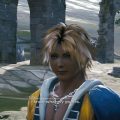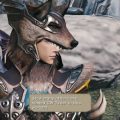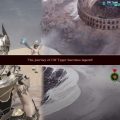Final Fantasy Retrospective: Mobius Final Fantasy, Act Two (Part 1)

 So by now, I’m sure you’re wondering, when will this end? The game’s gone. There’s no more. I didn’t even like the story.
So by now, I’m sure you’re wondering, when will this end? The game’s gone. There’s no more. I didn’t even like the story.
And yes, that’s true. The story was too much “The prophecy sucks. Let’s go against it. Except maybe we shouldn’t go against it. Let’s keep going and see what happens.” My preferred era of Final Fantasy is the “You spoony bard,” “This guy are sick” era anyway. The modern era is so full of misses that it’s a miracle Final Fantasy XIV is turning out so well.
So why am I continuing to torture myself? Well, I think we all want closure in life. We want to know what it all meant. We want our struggles to mean something, and there’s a sense of closure in finding out where the story went, even if we’ll never see anything beyond Act 2 of the game. Each act took so long to release, it’s like reading a chapter of a book every few months and trying to keep track of the story. That’s likely why each chapter of act one began by reminding players what the game’s about and where the story’s headed. Imagine if, between worlds in Kingdom Hearts III, Sora monologued about looking for allies in the fight against Xehanort and that his journey won’t be over until all the worlds are right, or something like that. Actually, in the hands of the right writer, that might actually improve Kingdom Hearts a little bit. Having Sora grow up a little and not be so naive all the time would help, as long as he doesn’t get all mopey at the same time. The Kingdom Hearts series of late has been trying to beat the “My friends are my power” out of him and that’s not the right way to mature him at all. Friendship becoming power is the basic formula of Final Fantasy, it’s what makes it work. It’s what makes most RPGs work. Even games that are much more philosophical in nature, like Xenogears, can still be described as a game where a band of misfits come together to kill God.
Case in point, the ending of Act One of Mobius had the Warrior of Light and Princess Sarah find the hope in each other to actually defeat Chaos in a much more permanent manner than what Vox had ever intended. The world itself was created to be a Black Mirror version of Final Fantasy, unbreakable and infinite. The Warrior shattered that mirror anyway and brought a true closure to the first of the two stories of the world of Palamecia. The prophecy was a horrific parody of the kind of prophecy narrative that permeates fantasy fiction, Meia’s Warrior tried to take the Yuna route and was killed for it, and even the trope of the princess as hero bait was laid bare for everyone to see how manipulative and objectifying it is.
In fact, let’s talk about that trope. I’ve mentioned it a few times prior to Mobius, but here the trope is very blatant in its use. In chapter three, it’s played so straight that the princess all but throws herself at the Warrior and then in chapter four, accompanies him to Mogheim out of some sense of loyalty to this warrior who for all she knows, might have attachments elsewhere that he no longer remembers.
And on that note, a quick digression: why did they not do a Final Fantasy IX crossover event with Sir Fratley waking up in Palamecia with no memory of his past, only a vague sense that he doesn’t belong in the world? They would have to tread the story very carefully and not drop too many hints that he has a special someone back home, since he’s supposed to have forgotten her by the time he’s found by Freya again. After an adventure in Palamecia, he would find his way home and express hope to the Warrior that his memory will return with time, and that any loved ones he’s left behind will forgive him for his amnesia.

I don’t quite recall Sarah’s motivation for following the Warrior other than she thinks she’s in love with him since that’s what the prophecy demands of her, but I have a theory. It’s possible that, even then, she was trying to take control of her own life and show some agency for once in her miserable life. Except that it’s suggested that she’s been along that path before, given her dialogue hinting that she finds it to be familiar. The letters that were found along the path hinted the same, but those later turned out to be red herrings anyway.
Her attempt at self-actualization is seemingly also a part of the cyclical story of Palamecia, and she’s quickly taken out of the way once more by having her stay behind in Mogheim. It’s like she knows she wants to be a more proactive element but she doesn’t know how to do it. It’s not until the final chapter, in the final stretch before facing Chaos, that Sarah finally comes into her own. She returns to the story not as an object to be won or fought over, but armed and ready to fight for the world she lives in.
It’s never revealed if she’s ever tried that in the past, but I choose to believe that it’s unique to this cycle and a much more sincere attempt by Sarah to break out of the mold she’s been placed in, that she’s finally realized her role in the world and she’s doing her best to change it. Even so, she’s got so much attachment to the world, no doubt planted inside her by Vox, that given the chance to leave the world for good, she doesn’t take it, and Vox is certainly counting on that, for he actually steals her out of Garland’s arms and forces her to stay. She’s his most precious plaything and he wants to turn her back into the object she was always intended to be.
He doesn’t care about any of his other playthings, just as long as they don’t break his precious Sarah or his precious Chaos, and when Sarah fires the arrow of pure hope at Chaos, this open defiance of Vox is what truly frees her character from her previous role. She is no longer the good little princess who thinks that she loves the Warrior of Light. I dare say it’s likely she doesn’t actually love him, she was just saying things out of duty. Is it possible that in Mobius, the princess was raised to see it as her duty to love the Warrior of Light, and she doesn’t actually feel that way? She gave the blessing for Meia and her Warrior to court, despite what the prophecy said.
Act one ended with a finality that meant that if there was never any more Mobius, it might be considered a satisfying ending. The world is going to change and although things are going to be difficult, the Warrior is optimistic. In his own words, it doesn’t feel like he won but it also doesn’t feel like he lost.
And yet in the prologue to the second act, the Warrior of Despair storyline, the characters begin by recapping what was bleedingly obvious to players who remember what happened in the first storyline. The first new actual information concerns the results of the Warrior’s actions. By defeating Chaos, a dark wave of energy wrapped itself around the planet, one that wiped everyone’s memories, same as before. Apparently, the way to fix Palamecia isn’t just to defeat Chaos, there are certain laws governing reality itself that need to be replaced before the world can truly be free.
I think the biggest reason for the way the game was written, full of repetition as well as sound and fury in the Shakespearian sense, is due to the structure of the game’s play. Most Final Fantasy games are fully realized worlds that can be explored, built to encourage a larger chunk of time investment each day. Mobius can be played in bite sized chunks, even if it’s possible to binge it. You could theoretically clear a node, go and do other things, come back and clear another node, go and do other things, and basically get only one small portion of dialogue per day. Repetition might not be that bad if spread out over a long time like that, but it also seems like a poor reward for one day’s ten minutes of play to have to sit through another scene of characters saying the same things and going nowhere for the effort.

Anyway, with a new storyline comes new characters. Sophie is a girl who’s feeling stifled by a seemingly heartless matron, one who she finds is tough to work for. She’s one of several scavengers looking for treasure, and she’s increasingly becoming disillusioned with her work. But just when she’s feeling her lowest, she finds an artifact called a runestone, and as soon as she picks it up, she begins seeing Final Fantasy X style flashbacks. Runestones function similarly to Movie Spheres, and in this one she sees a vision of a place known as Anozea. A dispute between the Collective and the Free Citizens plays out before her eyes. Given that this is a Final Fantasy game, these flashbacks are definitely important.
Sophie finds herself influenced by the Free Citizen and unable to resist, she starts acting like him and speaking his lines to the empty beach before her. This reminds me of Yuna’s joyous and uncontrollable dancing when she allowed one of her dressspheres to influence her behaviour for a moment during the start of Final Fantasy X-2.
The Runestones in Palamecia have one more trick up their sleeve, for Sophie finds herself transported to Anozea and finds herself absolutely convinced that the man who she saw speaking, the Free Citizen, is her brother. Unfortunately, she gets knocked out while within the world inside the runestone and she passes out, seemingly trapped.
Before introducing the other new character to the story, the game dutifully checks in on what the Warrior of Light is up to. He’s living in a town called Omega, fighting fiends out in the wild in order to earn his keep protecting the town and its people. The Dark Flood that wiped away everyone’s memories didn’t affect himself and Meia. Sarah voluntarily relinquished the memories of her past in the Dark Flood, including her identity as the princess. This doesn’t seem to have dampened her battle prowess, for she frequently spars with Meia, a fact which the Warrior is at first unaware.
If anyone remembers my confusion at the Warrior and Sarah being brother and sister, act two explains that by showing that the townsfolk of Omega assumed their familial relation and it was a lot easier to play along. Because her own memories were washed away, Sarah honestly believes they’re brother and sister, which is how come she acted like she was related to the Warrior during The Sleeping Lion. This is why jumping around in the timeline is a bad idea, you find yourself trying to make sense of details that you wouldn’t have had the chance to find out yet.
Sometimes it’s unavoidable, like when players of Final Fantasy XIV took up cooking and at the end of the level 50 quest, they found themselves preparing a meal for a character who was presumed dead after the events of patch 2.5. When players who had joined around that time noticed this incongruency, it was explained away that the Culinarian quests simply took place earlier in the timeline, but not at a specific point earlier.

The last character who is introduced in the second act of Mobius, Graff, wakes up in a similar manner as the Warrior of Light. With no memories of his past, he sets out to find his fortune in Palamecia. Somehow knowing his name (I guess waking up post-Chaos means you still retain your own identity), Graff adventures around, fencing his way to victory. He reminds me of a swashbuckling hero from an Errol Flynn film. That seems to be the aesthetic the writers are going for him, the boastful, confident hero of classic cinema. The Zorro of Palamecia.
Graff, too, finds the runestone that sucked Sophie in and ends up in Anozea. Graff’s experience is different from Sophie’s, for as he explores around, he finds himself almost remembering something of his past. Anozea seems to be familiar to him in all except its name.
Graff’s trip through the city influences Sophie’s, for he indirectly saves her from a fiend that otherwise would’ve killed her. In her story, she calls an unknown character her brother and in Graff’s first chapter, it’s revealed that he is the unknown character and that they are indeed brother and sister. Chapter one ends as the pair find each other.
In some ways, the first few chapters of the Warrior of Despair storyline play out in a somewhat Final Fantasy VIII style, where we go back and forth every so often between the main character we’ve already come to know, and a set of characters that at first doesn’t seem to have a lot to do with the story and who may or may not live in the current time.
The Warrior himself seems to be living Laguna’s life at the start of Disc 2 of the game, in that he’s doing various errands and chores and enemy culling for the village he finds himself living at. I struggle to find anything interesting about the Warrior’s life, since everyone around him won’t stop talking about their lost memories and what their past lives could’ve been. Graff and Sophie have a much more interesting story, and although the rebellion on Anozea doesn’t seem to have anything to do with the Warrior of Light and his peaceful life, there are hints from the beginning that the overall story of Palamecia and all the warriors the world has drawn to it from all corners of the universe might relate to the story of Graff and Sophie and the world of Anozea. I find myself entertaining the notion that maybe all the named characters in Palamecia had their origins on Anozea, or at least some of them.

It takes a long while before the Warrior’s storyline begins to pick up. He spends most of the first few chapters being a side quest errand boy, but eventually he hears about a tower being built and realizes that the change he feels happening in Palamecia is related to that tower. Sarah is also acting funny, so he eventually follows her to see what’s going on, and this is where he and Meia reunite. Her and the Warrior pretend that it’s their first time meeting in order to keep the amnesiac Sarah from asking questions.
The ending of chapter three makes it quite clear that the tower shown in the visions of the runestones is central to everything that’s going on, and it finally ushers in the actual plot of the Warrior of Despair story.
Compared to act one, the first few chapters of the second act of the game seem unfocused and in some ways, lacking in story. This might have just been to gradually introduce the player to changes in the battle system and give players time to get used to Sophie and Graff. Starting with chapter four, the game once again gets very interesting.
If there’s one thing I’ve noticed in my time spent in Mobius and my time looking into the parts of the story I was unable to experience, it’s that the number eight is very important to the game, mainly because if you tilt an 8 on its side, you get the infinity symbol and it also looks like a mobius strip. With that in mind, come back next week for the eighth and final article in Damage Control’s series on Mobius Final Fantasy.





